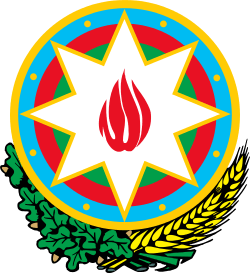Tourism in Azerbaijan
The historical, cultural and natural heritage of Azerbaijan attracts visitors from all over the world. Untouched nature, mineral springs, the world's only oil field treatment - naphthalene, a unique ancient architecture, unique culture, cuisine, and more contribute to the formation in Azerbaijan of all types of tourism: business, sport, medical, cognitive, hunting, exotic, beach and even gastronomic. Azerbaijan is a territory of 9 out of 11 of the world's climatic zones. The climate of the country enables to organize summer and winter holidays. Very common are ecological tours to Azerbaijan, which include visits to nature reservations, trekking and climbing routes. Midday sandy beaches offer opportunities for diving, and swimming season starts in Azerbaijan in May. Tourism sector in Azerbaijan is developing day by day, becoming one of the most important sectors of the economy.
Regulation
Tourism is regulated by the Ministry of Culture and Tourism of Azerbaijan.
Visa
Tourist visas can be obtained from Azerbaijani embassies around the world or through electronic visa online without going to any embassy. Starting from March 15, 2013 new procedure of tourist e-visa system has been implementing in Azerbaijan to provide the execution of the Decree of the President of the Republic of Azerbaijan dated November 20, 2012 ”On the facilitation of visa procedures for foreigners and stateless persons, traveling to the Republic of Azerbaijan”. With an aim to attract more tourists from all over the world, this new system is designed to transfer all visa applications to the electronic context which is very cheap, fast and easy. The visitors need to upload all necessary documents to www.evisa.com.az. After the relevant documents are prepared the www.evisa.com.az apply to the Ministry of Foreign Affairs for e-visa. When confirmed by MFA, e-visa is forwarded to visitors in electronic format. Henceforth, visitors just need to print out the e-visa and are free to visit the country via any modes of entry (by air, on land, by sea, etc.).[1]
Arrivals by country
It was not until the 2000s (decade) that the tourism industry began to recover, and the country has since experienced a high rate of growth in the number of tourist visits and overnight stays.[2] In recent years, Azerbaijan has also become a more popular destination for religious, spa, and health care tourism.[3]
The flow of tourists is increasing every year (according to official information in 2011 Azerbaijan was visited a record number of foreign nationals - more than 2.2 million), so in the capital and other tourist areas there is a growing number of hotels with the highest level of service. Today their number is more than 500.
Most visitors arriving to Azerbaijan in 2014 were from the following countries of nationality:[4]
| Rank | Country | Number |
|---|---|---|
| 1 | 843,851 | |
| 2 | 699,532 | |
| 3 | 314,476 | |
| 4 | 131,179 | |
| 5 | 58,201 | |
| 6 | 33,563 | |
| 7 | 29,468 | |
| 8 | 19,336 | |
| 9 | 14,543 | |
| 10 | 13,838 |
During the first six months in 2015, the highest numbers of foreign citizens who visited Azerbaijan came from Russia, Georgia, Turkey and Iran.[5]
Historical monuments
Walled City of Baku with the Shirvanshah's Palace and Maiden Tower
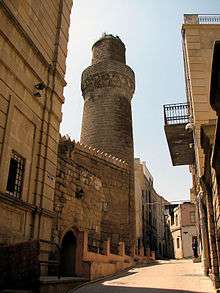
The Azeri city of Baku has numerous historical and architectural monuments dating to various historical epochs.
The Walled City of Baku is the ancient historical core of Baku. In December 2000, the Old City of Baku, including the Palace of the Shirvanshahs and Maiden Tower, became the first location in Azerbaijan to be classified as a World Heritage Site by UNESCO.
The Walled City of Baku or Icheri Sheher hosts over 50 historical and architectural monuments from various eras. The Palace of the Shirvanshahs, the Maiden Tower and Synyg Gala (The Broken Tower) are among the monuments which survived until present day. The Palace of Shirvanshahs is one of the pearls of Azerbaijani architecture. It was built in the beginning of the 15th century. It includes a historical complex, the palace, a divankhana, the Shirvanshah's room, a palace mosque with minarets, bath house, a room of Seyid Yahya Bakuvi, and the Western divankhana monuments, which were built during a later stage. The complex construction began in 1441, while the Western divankhana was completed by architect Amirshah in 1558.
Azerbaijan's unique architectural monument - the Maiden Tower is located in the south-western part of the Walled City of Baku or Icheri Sheher. The tower was built in two stages. Its bottom part with a height of 13.7 meters is dated by most experts to the 6th-7th centuries BC. The Maiden Tower has a total height of 29.7 meters, with a diameter of 16.5 meters. The wall thickness in the bottom part is 5 meters, reducing to 4 meters at the top. The tower consists of 8 tiers and has a 21 meter deep water well. It was built by the 12th century architect Masud ibn Davud, who was probably the father of the architect of Mardakan Round Tower (not to confuse with Mardakan castle).[6] Its foundation are believed to be a Sasanid era Zoroastrian site.[7]
Ateshgah of Baku
Another interesting sight in Baku is the Ateshgah temple, situated in south-western part of the Surakhani settlement in the Absheron peninsula, 30 km away from Baku. Ateshgah is a fire temple, built in the 17th-18th centuries. The temple's central stone shrine is located on a natural gas pocket. The present structure was built approximately in 1713 AD, and the building of the central stone shrine was funded by merchant Kanchanagaran in 1810.
The Absheron peninsula, which is famous for oil oozing out of the ground naturally, as well as for natural oil fires.[8] Zoroastrianism has a long history in Azerbaijan and the lands of Absheron were held to be sacred by Zoroastrians due to these natural fires.[8]
Some scholars have speculated that the Ateshgah may have been an ancient Zoroastrian shrine that was decimated by invading Islamic armies during the Muslim conquest of Persia and its neighboring regions.[9]
The complex was turned into a museum in 1975 and now receives 15,000 visitors a year. It was nominated for World Heritage Site status in 1998 and was declared a state historical-architectural reserve.
Gobustan Rock Art Cultural Landscape
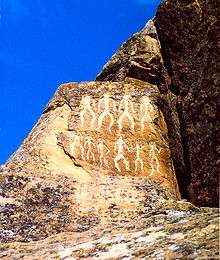
One of the most ancient and exciting monuments of Baku is Gobustan, famous around the world for its rock carvings. Gobustan Rock Art Cultural Landscape was established in 1966 when the region was declared as a national historical landmark of Azerbaijan in an attempt to preserve the ancient carvings, mud volcanoes and gas-stones in the region.
Gobustan is very rich in archeological monuments, the reserve has more than 6,000 rock engravings dating back between 5,000 - 40,000 years. The site also features the remains of inhabited caves, settlements and burials, all reflecting an intensive human use by the inhabitants of the area during the wet period that followed the last Ice Age, from the Upper Paleolithic to the Middle Ages. The site, which covers an area of 537 ha, is part of the larger protected Gobustan Reservation.[10]
Most of the rock engravings depict primitive men, animals, battle-pieces, ritual dances, bullfights, boats with armed oarsmen, warriors with lances in their hands, camel caravans, pictures of sun and stars.[11]
In 2007 Gobustan was declared a UNESCO World Heritage Site of Universal value. It is the most popular reserve and is an invaluable treasure-house of Azerbaijan.
Mardakan castles
There are two ancient towers in the Mardakan settlement of Baku. The one with a quadrangular form was built in the 12th century by Akhsitan, the son of Shirvanshah Mechehrin. This tower was erected on occasion of Akhsitan's victory over his enemies. The tower has a height of 22 meters. The wall thickness in the bottom part is 2.60 meters, reducing to 1.60 meters at the top. The insides of the tower are divided into five tiers. The second tower has a rounded shape and is known as Shih Tower among the local population. This tower has a height of 12.5 meters. Its inner part consists of three circles. The inscription on the tower wall reads that it was built by the architect Abdulmejid Masud in 1232.
Palace of Shaki Khans
The Palace of Shaki Khans in Shaki was a summer residence of Shaki Khans build in early 18th century. It features decorative tiles, fountains and several stained-glass windows. The exterior is decorated with dark blue, turquoise and ochre tiles in geometric patterns and the murals were coloured with tempera and are inspired by the works of Nizami Ganjavi.[12]
National Parks
The climate of Azerbaijan is unique, as nine of the Earth's 11 climate zones can be found in Azerbaijan.[13] As a country located in the Caucasus and Minor Asia between the Black Sea and Caspian Sea, Azerbaijan has a rich culture, widest biodiversity among the European states and enormous natural resources. National Parks serve to the purposes of environmental protection, educational, scientific, cultural researches, etc. Azerbaijan has a total of 8 national parks.
Zangezur National Park
The Zangezur National Park (it was renamed and expanded in 2009 from former Ordubad National Park) is characterized by rich biological diversity. It has 58 species of animals (35 of vertebrates and 23 of insects) and 39 species of plants which are included into the Red Book of Azerbaijan. The National Park comprises such rare and endangered species as Anatolian leopard, the mountain sheep-moufflon, bezoar goat, white-tail sea eagle, golden eagle, little bustard.
Shirvan National Park
The Shirvan National Park has a semi-desert landscape and water body of approximately 40 square kilometres. The national park has an extremely rich ornithological fauna. Rare and valuable species of birds (turaj, little bustard, bustard, swans, flamingo, etc.) winter and nest in the marshy areas. Djeyran gazelles are the most widely spread mammals in the region.
Ag-Gol National Park
Ag-Gol National Park is located in the Mil plain of the Kur-Araz lowlands, it has semi-desert landscape and deserved the title of a bird paradise, as the most important winter and nest place of birds. The ornithological fauna of this reserve is very rich. Over 140 species of birds are found in this place including 89 species of nesting birds (Partridge, spoonbill, swan, teal, bustard, etc.). Ag-Gol national park is designed to protect the marshy ecological systems, as the nesting and wintering places of migratory and water birds. Ag-Gol has been incorporated into the list of UNESCO's convention "On internationally important marshy areas as the residing places of birds"
Hirkan National Park
Hirkan National Park is located in the Lenkoran Lowland and the Talysh Mountains, and is 99% covered by forests in a primarily mountainous region, and is strictly protected.
Hirkan National Park preserves relict and endemic plants species of Tertiary period. Forests of Hirkan account for 150 out of 435 types of trees and bushes. One can come across such types of trees, included into the Red Book of Azerbaijan as, Hirkan box tree, iron tree, chestnut leave oak, fig-tree, Hirkan pear-tree, Silk Acacia, Caucasus palm-tree, Caspian gleditsia, butcher's broom, alder-tree, such animals as the Persian leopard, the Talysh pheasant, golden eagle, etc.
Altyaghach National Park
The area of Altyaghach is 90.5% covered by temperate deciduous broadleaved forests. The major types of trees are iron trees, Caucasus hornbeam, Oriental beech, cud, birch-tree, etc. The national park is home to the rare East Caucasian tur (Capra cylindricornis), a mountain dwelling goat antelope found only in the eastern half of the Caucasus Mountains. Animals as the roe deer, bear, wild boar, lynx, fox, rabbit, squirrel, wolf, etc. are found on the territory of this park.
Absheron National Park
The predecessor of Absheron National Park during Soviet times was the Absheron State Nature Preserve which was created in July 1969 in order to protect gazelle, Caspian seal and water birds inhabited in the territory. The climate of the area is mild-hot, specific to semi-desert and dry steppe. Types and phytomass of flora is too poor here, plants are changed respective of water and saltiness regime of area. Sea coastal sand plants (42,6%), meadows with jigilgamish and paz grass (13,2%), one-year saline grasses (5,2%) etc. are spread. Ephemeras also develop well in early spring. In dry area gazelle, jackal, fox, rabbit, badger, in Caspian waters seal and various fishes, birds such as silver gull, wheezing swan, grey and red-headed black, white-eyed black ducks, big white bittern, sandpiper, bald-coot, marsh belibagli, sea bozcha and other migrant birds have inhabited here. Animals and birds inhabiting in Shirvan National Park, names of which have been included in the Red Books, exist in Absheron National Park as well.
Shakhdag National Park
The Shakhdag National Park was created in 2006, and became the largest national park not only Azerbaijan but in the whole Caucasus.
The Shakhdag National Park is located in northern Azerbaijan, on the border with Russia and Georgia at the Greater Caucasus Mountains. The World Bank has allocated a $17 million loan and $8 million grant for the national park's creation, while the government of Japan has provided $8 million as a grant for the project implementation. Shakhdag National Park will help address ecological issues and build a tourist infrastructure in the Caucasus for visitors .
Göygöl National Park
The Göygöl National Park was created in 2008 and is currently the newest national park of Azerbaijan. The predecessor of Göygöl National Park during Soviet times was the "Goy Gol State Reserve" that was established in 1925. The Göygöl National Park is located in eastern Azerbaijan, on the northern slopes of the Lesser Caucasus and includes Lake Göygöl after which it is named. The area of Göygöl is almost entirely covered by forests and has a rich flora with over 420 plant species, including 20 which are endemic to the area. It also has mammals such as brown bears, Caucasian red deer, roe deer, and lynx, and birds such as the lammergeyer, raven, mountain partridge.
Promotion of tourism

The shirt sponsor of Atlético Madrid is Azerbaijan which aims to promote tourism in Azerbaijan.
Touristic venues
Hotels, recreation, entertainment and sports centres operate also in the regions of Azerbaijan - a chain of hotels and amusement park Qafqaz Gabaland in Gabala, the epic winter and summer tourist complex “Shahdag” in Gusar region, more than 15 Olympic sports complex having necessary infrastructure for receiving tourists all over the country, etc. All this indicates that tourism in Azerbaijan is one of the priorities of the state policy and holds great promise for economic development.
Museums
Most of the museums are located in the major cities of Azerbaijan such as Baku, Ganja, Nakhchivan, Sumgait, Lankaran, Mingachevir and Shaki. Some of these include:
|
|
Gallery
-
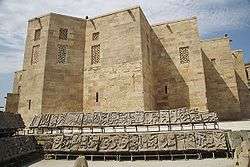
Palace of the Shirvanshahs, Baku (UNESCO World Heritage Site)
-

Maiden Tower, Baku (UNESCO World Heritage Site)
-

Inner City (UNESCO World Heritage Site)
-
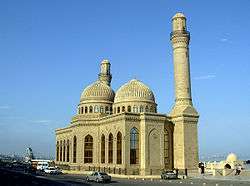
Bibi-Heybat Mosque, Baku
-
Mardakan Castle, Baku
-
Landscape in Quba
-
Waterfall in Lerik
-

Valley in Ismayilli
-
City tour buses for tourists
See also
- Visa policy of Azerbaijan
- Ministry of Culture and Tourism (Azerbaijan)
- Culture of Azerbaijan
- Nature of Azerbaijan
References
- ↑ Evisa.com.az
- ↑ Azərbaycan Qarabağın turizm imkanlarını təbliğ edir (Azerbaijani)
- ↑ Baku Boom Has Yet to hit regions
- ↑ Number of foreign citizens arrived to Azerbaijan by countries
- ↑ http://vestnikkavkaza.net/news/Russian-tourists-fall-in-love-with-Azerbaijan.html
- ↑ Ашурбейли Сара. История города Баку: период средневековья. Баку, Азернешр, 1992; page 149
- ↑ http://www.goroskop.8m.net/avesta1.html
- 1 2 Marshall Cavendish (2007), Peoples of Western Asia, Marshall Cavendish Corporation, ISBN 0-7614-7677-6,
... Oil oozes up out of the ground in the region of the Apsheron ... natural oil fires were revered long ago by Zoroastrians, to whom fire is a sacred symbol ...
- ↑ Ervad Shams-Ul-Ulama Dr. Sir Jivanji Jamshedji Modi, Translated by Soli Dastur (1926), My Travels Outside Bombay: Iran, Azerbaijan, Baku,
... 'maybe, that before Moslem epoch it was Zoroastrian Fire Temple, which was destroyed by Arabs and later was restored by Hindu people for their purposes' ... Farroukh Isfandzadeh ... Not just me but any Parsee who is a little familiar with our Hindu brethren’s religion, their temples and their customs, after examining this building with its inscriptions, architecture, etc., would conclude that this is not a Parsee Atash Kadeh but is a Hindu Temple ... informed me that some 40 years ago, the Russian Czar, Alexander III, visited this place with a desire to witness the Hindu Brahmin Fire ritual ... gathered a few Brahmins still living here and they performed the fire ritual in this room in front of the Czar ... I asked for a tall ladder and with trepidation I climbed to the top of the building and examined the foundation stone which was inscribed in the Nagrik [or Nagari] script ... the installation date is mentioned as the Hindu Vikramaajeet calendar year 1866 (equivalent to 1810 A. D.) ...
- ↑ whc.unesco.org Gobustan Rock Art Cultural Landscape > Brief Description
- ↑ Gobustan Reserve
- ↑ David C. King. Azerbaijan, Marshall Cavendish, 2006, p. 99
- ↑ cac-biodiversity.org - Climates of Azerbaijan
External links
| Wikivoyage has a travel guide for Azerbaijan. |
| Wikimedia Commons has media related to Tourism in Azerbaijan. |


.jpg)
